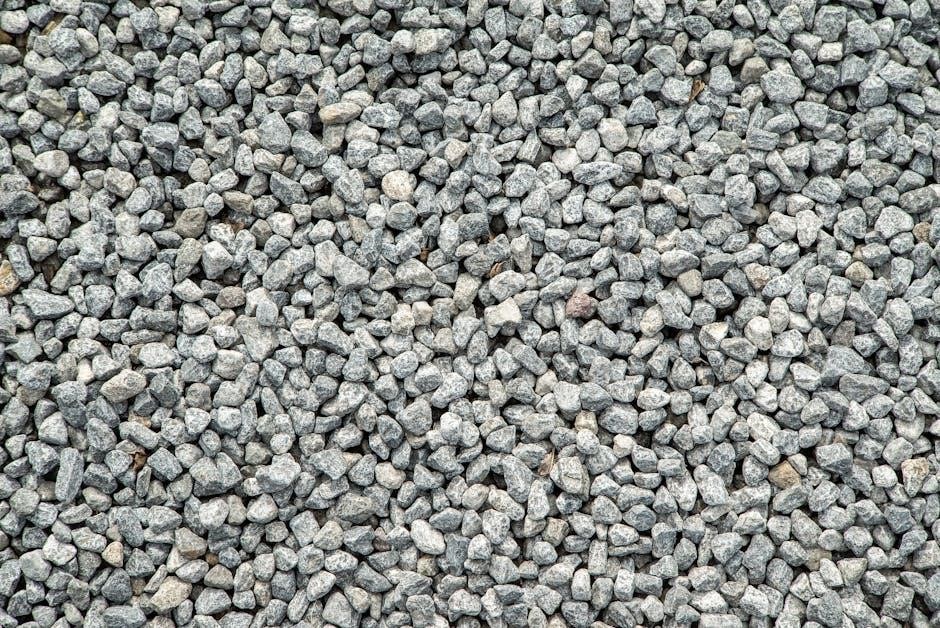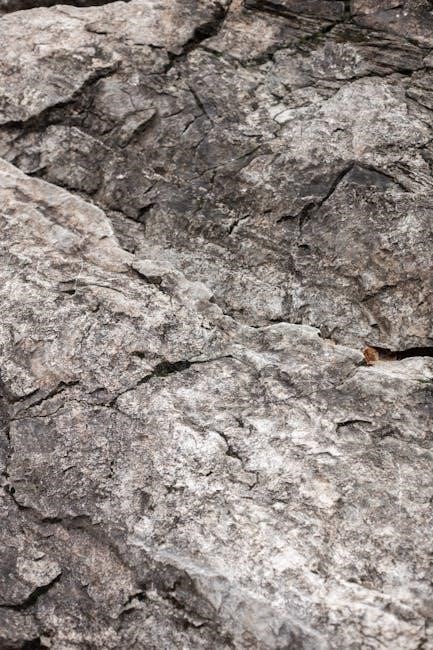A sharpening stone grit guide is essential for understanding how different grit sizes shape, refine, and polish edges. This guide helps you choose the right tools for optimal sharpening results.
1.1 Overview of Sharpening Stones and Their Importance
Sharpening stones are essential tools for maintaining and enhancing the cutting edges of knives, tools, and other blades. They work by grinding and honing the metal to achieve precise sharpness. Available in various types, such as water stones, oil stones, and diamond stones, they cater to different sharpening needs. Sharpening stones are widely used by chefs, woodworkers, and outdoor enthusiasts to ensure their tools perform optimally. Their importance lies in their ability to restore and refine edges, making them indispensable for professionals and hobbyists alike. Regular use of sharpening stones prolongs tool life and ensures consistent performance.
1.2 Understanding Grit and Its Role in Sharpening
Grit refers to the size of abrasive particles on a sharpening stone, determining its effectiveness. Lower grit (coarse) removes metal quickly, while higher grit (fine) polishes the edge. The grit range typically spans from 400 to 6000+, with each level serving a specific purpose. Coarse grits (400-1000) shape and repair edges, medium grits (1000-3000) refine, and fine grits (3000-6000+) polish. Understanding grit is crucial for selecting the right stone, as improper grit can damage tools or fail to achieve desired sharpness. Proper grit progression ensures efficient sharpening, preventing over-sharpening and maintaining tool longevity.

The Sharpening Process: A Step-by-Step Guide
The sharpening process involves progression through coarse, medium, and fine grit stones to shape, refine, and polish edges, achieving desired sharpness and a mirror finish.
2.1 Coarse Grit Stones (400-1000 Grit): Shaping the Edge
Coarse grit stones (400-1000 grit) are the starting point for sharpening, used to shape and repair edges. These stones quickly remove metal, making them ideal for restoring damaged or dull tools. A 400-grit stone is aggressive, removing material rapidly to correct major edge issues, while a 1000-grit stone refines the edge, preparing it for further sharpening. This stage is crucial for setting the foundation of the edge, ensuring proper alignment and shape. However, coarse grits should be used sparingly to avoid excessive metal removal, as they are designed for initial shaping rather than final polishing.
2;2 Medium Grit Stones (1000-3000 Grit): Refining the Edge
Medium grit stones (1000-3000 grit) are used to refine the edge after shaping with coarse grits. These stones remove less metal but produce a smoother, sharper edge. A 1000-grit stone continues refining the edge, while 3000-grit stones prepare it for polishing. This stage enhances sharpness and reduces visible scratches, creating a more refined cutting edge. Medium grits are versatile, suitable for both maintaining and improving edge quality. They are essential for transitioning from coarse to fine sharpening, ensuring the edge is properly prepared for the final polishing stage with higher grit stones.
2.3 Fine Grit Stones (3000-6000 Grit): Polishing the Edge
Fine grit stones (3000-6000 grit) are designed for polishing and refining the edge to a high-luster finish. These stones remove minimal metal but enhance sharpness and edge clarity. A 3000-grit stone transitions from refining to polishing, while 6000-grit stones create a mirror-like finish. Fine grits are ideal for final touches, reducing micro-scratches, and achieving a razor-sharp edge. They are best used after medium grits, ensuring a smooth progression in sharpening. Fine grit stones are essential for tools requiring precision and are often used for maintaining and enhancing already sharp edges without excessive metal removal.
2.4 Polishing Stones (6000+ Grit): Achieving a Mirror Finish
Polishing stones (6000+ grit) are used for achieving a mirror-like finish on edges. These ultra-fine stones remove microscopic scratches, creating a polished edge that enhances sharpness and durability. Typically used after fine grit stones, they are ideal for high-end tools and knives. Polishing stones are available in various types, including diamond, ceramic, and natural stones. They are essential for professional-level sharpening, ensuring the edge is not only sharp but also visually flawless. Regular use of polishing stones can extend the life of tools by maintaining their edge quality and appearance.

Factors Influencing Grit Selection
Steel type, edge condition, sharpener’s skill level, and tool type are key factors in selecting the appropriate grit for sharpening. Each factor impacts the sharpening process uniquely.
3.1 Steel Type and Hardness
Steel type and hardness significantly influence grit selection. Harder steels require finer grits to maintain sharpness, while softer steels may need coarser grits for effective edge shaping. The metal’s composition determines how it responds to abrasion, guiding the choice between coarse, medium, or fine grit stones. For instance, high-carbon steel, commonly found in knives, benefits from a progression starting with coarse grits for shaping and moving to finer grits for polishing. Understanding the steel’s properties ensures the sharpening process is both efficient and effective, preventing unnecessary wear on both the tool and the sharpening stone.
3.2 Edge Condition and Desired Sharpness

The condition of the edge and the desired level of sharpness are critical factors in selecting the appropriate grit. A dull or damaged edge may require starting with a coarse grit (400-1000) to reshape and remove metal efficiently. For edges that are only slightly dull, a medium grit (1000-3000) is often sufficient to restore sharpness. The final desired sharpness determines the progression to finer grits (3000-6000+), ensuring a polished, razor-sharp edge. Matching the grit sequence to the edge’s initial state and the intended use of the tool guarantees optimal results and minimizes unnecessary wear on the sharpening stones.
3.3 Skill Level of the Sharpener
The sharpener’s skill level significantly influences grit selection. Beginners often benefit from starting with medium-grit stones (1000-3000) to avoid over-aggressive sharpening. Intermediate sharpeners can effectively use a combination of coarse and fine grits to refine edges. Advanced users may prefer finer grits (3000-6000+) for precise polishing. Regardless of skill level, understanding how grit progression affects edge quality is crucial. Proper grit selection ensures efficient sharpening while minimizing the risk of damage to the tool or stone. Practice and experience enhance a sharpener’s ability to choose the right grit for the desired outcome, making the sharpening process more effective and consistent.
3.4 Type of Tool Being Sharpened
The type of tool being sharpened plays a crucial role in grit selection. For instance, knives typically require a progression from medium to fine grits (1000-6000+), while axes or chisels may benefit from coarser grits (400-1000) to remove metal quickly. Tools like scissors or plane irons may need specialized grits depending on their intended use. The tool’s edge geometry and intended function dictate the appropriate grit range, ensuring effective sharpening and maintaining the tool’s performance. Understanding these specific needs is essential for achieving the desired edge quality and longevity.

Grit Progression and Combination
Grit progression is crucial for effective sharpening, ensuring each stage builds on the previous. Combining different grits optimizes edge refinement, from shaping to polishing, enhancing overall sharpness and durability.
4.1 The Importance of Grit Progression in Sharpening
Grit progression is vital in sharpening as it ensures a systematic approach to edge refinement. Starting with coarse grits removes metal efficiently, shaping the edge. Medium grits refine the edge, reducing scratches. Fine grits polish the edge, enhancing sharpness and smoothness. Skipping grits can leave scratches, making the process less effective. A proper progression ensures each step builds on the previous, leading to a sharper, more durable edge. This method is essential for both beginners and experienced sharpeners, optimizing results and maintaining tool longevity.

4.2 Recommended Grit Combinations for Different Tools
Choosing the right grit combination depends on the tool and its intended use. For knives, a common progression is 400-1000 grit for shaping, 3000-6000 for refining, and 8000+ for polishing. Axes benefit from 400-1000 grit for shaping and 3000 grit for final sharpening. Chisels often use 1000-3000 grit for refining and 6000+ for polishing. Scissors may require 400-1000 grit for shaping and 3000 grit for finishing. The progression ensures optimal edge preparation, maintaining tool longevity and performance. Proper grit selection enhances sharpness and durability, tailored to the tool’s specific needs and steel type.
4.3 Transitioning Between Grits for Optimal Results
Transitioning between grits is crucial for achieving a sharp, polished edge. Start with a coarse grit to shape the tool, then progress to medium grit for refinement. Fine grits polish the edge, while polishing stones achieve a mirror finish. Always clean the tool and stone between transitions to prevent cross-contamination. Using a consistent angle and maintaining proper stone lubrication ensures even wear. Progressing gradually prevents skipping steps, which can leave scratches. This methodical approach enhances edge quality and extends tool life, ensuring each grit stage builds on the previous one for a flawless finish.

Selecting the Right Sharpening Stone
Selecting the right sharpening stone depends on factors like oil vs. water stones, diamond vs. ceramic types, and natural vs. synthetic materials to best suit your sharpening requirements.
5.1 Oil Stones vs. Water Stones: Key Differences
Oil stones and water stones differ primarily in their lubrication methods and performance. Oil stones require lubrication with petroleum-based oil, enhancing cut resistance and durability, while water stones use water, offering faster sharpening and easier cleanup. Oil stones are ideal for coarse grit operations and long-lasting use, whereas water stones suit fine grit sharpening and portability. Each type has unique benefits, catering to specific sharpening needs and preferences.
5.2 Diamond Stones and Ceramic Stones: Pros and Cons
Diamond stones are renowned for their exceptional durability and consistent performance, offering precise sharpening across various grits. They excel in both coarse and fine sharpening, making them versatile tools. Ceramic stones, while less durable, provide a balanced sharpening experience and are often more affordable; Diamond stones are ideal for heavy-duty use but can be more expensive, while ceramic stones strike a balance between performance and cost, though they may lack the longevity of diamond stones. Both options cater to different sharpening needs, offering unique advantages depending on the user’s preferences and requirements.
5.3 Natural vs. Synthetic Stones: Which to Choose
Natural stones, like Arkansas stones, are prized for their unique, natural abrasives, offering exceptional polishing abilities and a premium finish. However, they can be rare, expensive, and vary in quality. Synthetic stones provide consistent grit and durability, making them more accessible and reliable for everyday use. Natural stones are ideal for fine polishing and mirror finishes, while synthetic stones excel in versatility and affordability. The choice depends on personal preference, budget, and sharpening goals, with natural stones appealing to enthusiasts and synthetic stones suiting most sharpening needs effectively.
Understanding grit and progression is key to effective sharpening. Additional resources like books, online forums, and tool reviews can further enhance your sharpening skills and knowledge.
6.1 Summary of Key Points
Understanding sharpening stone grit is crucial for achieving optimal edge sharpness. Coarse grits (400-1000) shape edges, medium grits (1000-3000) refine, and fine grits (3000-6000) polish. Polishing stones (6000+) create mirror finishes. Factors like steel type, edge condition, and tool purpose influence grit selection. Progression through grits ensures even sharpening. Oil, water, diamond, and ceramic stones offer different advantages. Natural and synthetic stones vary in performance. Proper technique and grit progression are vital for desired results. Additional resources, such as guides and tool reviews, can deepen your understanding and improve sharpening skills.
6.2 Recommended Reading and Tools for Further Learning
For deeper understanding, explore resources like The Knife Sharpening Guide and Sharpening Stones: A Comprehensive Guide. Tools such as flattening stones, blade angle guides, and sharpening bases enhance your process. Online forums and tutorials provide hands-on insights. Investing in premium stones like Shapton Pro or Apex ensures quality results. Combine these resources to refine your sharpening skills and achieve professional-level sharpness consistently.



0 Comments